“Früher war die Zukunft auch besser”
(K. Valentin)
“Perfino il futuro una volta era meglio”
(K. Valentin)
“In the past, even the future was better” ( K. Valentin )
Monaco di Baviera, 4 Giugno 1882.
Sembrava un giorno qualunque, in Baviera, mentre veniva alla luce Valentin Ludwig Fey, meglio conosciuto come Karl Valentin (Pronunciate la “V” come una “F”, gentilmente, proprio come fanno i bavaresi.)
Il suo “genio universale”, così come tutti concordano da queste parti, lo rese attore, comico, produttore cinematografico, regista, scrittore. Un avanguardista, un acrobata delle parole, antesignano dell’assurdo, un Artista vero e proprio, per come la vedo io.
Munich, Bavaria June 4th 1882
It seemed just like another day, in Bavaria, when Valentin Ludwig Fey – better known as Karl Valentin ( and please, respectfully pronounce the V as if it were an F, Bavarians will thank you ) – was born.
The universal genius, as everyone here in Germany agrees to call him, was an actor, a stage comedian, a film director, a producer and a writer. He was a pioneer, a word acrobat, the master of the absurd. A true artist, if you ask me.
Fu un attore innovativo che influenzò moltissimo la cultura tedesca del tempo, il Charlie Chaplin bavarese, come lo stesso Bertolt Brecht lo definì (Bertolt Brecht, non uno scemo qualsiasi).
La sua comicità, che spesso puntava il dito con ironia verso la mentalità e le abitudini bavaresi, non solo lo condussero “lontano”, ma ancora oggi l’eco della sua arte riecheggia sulle scene tedesche, e le sue opere sono state tradotte in molti paesi. I suoi personaggi calcarono i palcoscenici di Vienna, Monaco, Berlino, Francoforte, Zurigo, fu amato dal pubblico di allora ed è ricordato con amore da quello di oggi. Insieme a Liesl Karlstadt creò il duo comico degli anni Venti più famoso del paese: erano una coppia ben assortita, in effetti. Lui così magro e lungo, lei paffutella, robusta, due facce simpatiche già al primo sguardo e due talenti insoliti che a me hanno rubato il cuore.
His uniqueness and his odd, creative skills significantly influenced the German culture in the early years of the twentieth century. Bertold Brecht named him after one of his greatest heroes, Charlie Chaplin; becoming the Charlie Chaplin of Germany, a nickname the whole nation enjoyed as well. ( Bertold Brecht wasn’t really a nobody, you know? I’m just saying )
Due to the nature of his ironic satire, Karl Valentin fast became a German cultural icon and still today, his art echoes on numerous German stages and his acts are being reproduced in several different countries too. His illogical and sarcastic characters have been performed on some of the most famous theatre stages such as Vienna, Munich, Berlin, Frankfurt and Zurich, to mention a few. He was well appreciated then and he’s still a loved and respectable artist today.
His stage partnership with Liesl Karlstadt made them become the most prominent duo and Bavaria’s biggest stars of that era. They were a very diverse couple: he was tall and skinny, she was chubby and well rounded. They were cute together, everyone loved their unusual, exceptional talent. I did too, they both stole my heart!
Tutto fu teatrale, in lui, perfino la sua morte: si dice che rimase accidentalmente chiuso in un teatro, e che morì pochi mesi dopo quella notte, per dei problemi polmonari dovuti al freddo patito sulle assi del suo amato palcoscenico. Era il 9 Febbraio 1948.
Everything was dramatic about Valentin, even his death: rumor has it he was accidentally locked inside a theatre and, a few months after that night, he passed away because of pulmonary complications due to the cold temperatures of his beloved stage. It was February 9th, 1948.
Monaco di Baviera, 2015.
Esiste un posto, qui, che ricorda questi due grandi artisti, il Valentin Karlstadt Musäum (l’unico Museo tedesco il cui nome si scrive alla bavarese, usando la lettera “ä” al posto della “e”). E’ un tempio della comicità vero e proprio, e tutto all’interno è bizzarro.. a partire dall’edifico stesso, concepito su tre piani che ruotano su una scala a chiocciola e le cui pareti sono tutte circolari. Una bellezza unica, per me.
Munich, Bavaria 2015
There’s a place here commemorating both artists, it’s called the Valentin Karlstadt Musäum ( the only German Museum whose name is spelled in Bavarian, using the letter “ä” instead of the “e” ). It’s a temple of funny and comical exhibits. Everything about the Musäum is bizarre, starting from the museum itself: it’s raised on three stories hugged by a winding staircase and rounded walls. I found it to be a true masterpiece
In realtà conoscevo Valentin già prima di trasferirmi qui, e non so dire con esattezza perché ci ho impiegato così tanto prima di andare a trovarlo. Il fatto è, però, che quella mattina avevo un gran voglia di ridere, di sentirmi leggera e allegra, e allora mi è venuto in mente questo museo. Non sono andata da sola, bensì con la mia amica Ines, una ragazza croata che il tedesco lo sa come la sua lingua, che mi ha accompagnato in questo viaggio comico col suo sorriso smagliante (e una borsetta marrone splendida!).
Si entra da una porticina, l’ingresso è davvero piccolo, non aspettatevi porte lussuose, ve lo dico. Gli orari di apertura sono bizzarri (dalle 11.01 alle 17.29) e vi posso assicurare che sono rispettati al secondo. Siamo sempre in Germania, che volete.
Il nostro entusiasmo era alle stelle già dopo i primi gradini.. e poi arrivi al primo piano e inizia la magia. La magia, almeno per me, di vedere il mondo di Valentin proprio davanti agli occhi, le sue foto, le facce buffe, i programmi dell’epoca, i suoi amati strumenti musicali originali, lui nei panni del mio personaggio preferito, Gigerls il gigolò teppista, i suoi oggetti bizzarri come “il plastico di neve sciolto” e “le rare gocce di sudore degli impiegati pubblici”. Ah già, dimenticavo, la sua ars comica è ancora molto attuale (giusto per essere un tantino polemica).
Honestly, I have been knowing Valentin for quite some time now, even before I moved to Germany, so, I’m not exactly sure why I waited so long to visit him, but that morning I just needed to laugh out loud, feel light and happy and visiting the museum was a no brainier at that time. I didn’t go alone, my friend Ines, a Croatian girl whose German is as fluent as if it were her own language, came with me to the funny Musäum, bringing along her flawless smile and a gorgeous brown handbag!!!
The entrance is really really tiny so don’t expect huge luxurious doors, I’m just warning you. Visiting hours are bizarre as well – from 11:01am to 5:29pm – and, needless to say they are always respected. We’re in Germany, after all.
We were already over the moon after going up the first few steps and, as soon as we approached the first floor, the magic began. To me magic means seeing Valentin’s life right in front of my eyes. Looking at his photos, staring at his funny faces, reading his event calendars, and touching his authentic musical instruments. It was pure bliss to me. Seeing him interpret my favorite character: “Gigerls the male escort thug”, checking out his bizarre pieces like the “melted snowman” and the “rare drops of sweat of public employees” ( is his comical talent still very actual these days by the way? Sorry, I’m feeling a little argumentative today ), was a dream come true.
C’è proprio di tutto, a testimonianza di quanto ancora sia un motivo di fierezza nazionale.. io e Ines abbiamo girato in tondo non so quante volte, lei lì a tradurmi le citazioni di Valentin, che nel museo sono scritte sui muri, e io a scattare senza tregua nel gesto tipico dei maniaci compulsivi. Che poi, a dirla tutta, abbiamo riso molto, un po’ perché certe frasi sono intraducibili – perché frutto di giochi di parole e nonsense – un po’ perché le sue facce e quelle della sua partner sono già tutte un programma. Eravamo di buon umore, e vi confesso che mi sono ritrovata più volte a ringraziarlo, quel genio, ovunque sia ora.
There was everything and more that told Valentin’s life at the Musäum, which shows how the pride for this artist still stands strong in this nation. Ines and I walked around I don’t know how many times. She patiently translated Valentin’s most popular quotes for me, which are written all over the walls of the Musäum, and I kept clicking away, as if I had the worst case of OCD. We laughed a lot, for both his quotes, impossible to translate because written out of nonsense and twisted words, and the crazy faces him and his partner made that were absolutely priceless. All that put us in a really good mood and I caught myself thanking the genius in different occasions that day. God bless him, wherever he is now..
Al secondo piano c’è la parte della mostra dedicata al lavoro svolto al cinema, e al talento indiscutibile di Liesl Karlstadt: ho letto che Valentin la conobbe nel 1911 e ne capì subito il talento comico. A lei dava il merito del loro successo dicendo “Sappiate che tutto questo è dovuto a lei. Lei ha fatto tutto, io non avrei potuto farlo, sono un tipo troppo nervoso.” Non era vero, ovviamente, ma certo c’è da dire che fu una donna sopra le righe, e per questo la ringrazio.
There’s an exhibition dedicated to his film career, running on the second floor, and to the unquestionable talent of Liesl Karlstadt. I read that Valentin first met her in 1911 and understood there was something special about her from the get go. He used to “blame” their success on her saying ” all this wouldn’t be possible without her, I could have never done this by myself, I’m too much of a constant train wreck “. Of course that wasn’t true, he was a real gentleman but she wasn’t just your average woman either, and for that, I thank her too.
Sempre al secondo piano, mentre sulle pareti rosse piccoli schermi danno a ripetizione le immagini -documentario dei film e degli sketch comici, potete ammirare alcuni costumi di scena, rimirarvi in uno specchio deformante che ovviamente io e Ines abbiamo amato subito, provare i cappelli della Karlstadt. Quelli veri, di scena, cavolo. Secondo voi io che ho fatto?
Still on the second floor, while little screens repeatedly played parts of documentaries and funny sketches on the red walls of the Musäum, we admired some of the original stage costumes and had the chance to stand in front of a deformable mirror which, you guessed it, Ines and I loved playing with. We tried all of Karlstadt’s hats on. The original ones, you guys, can you actually believe that? I mean, when am I going to have another opportunity like this again?? And what do you think I did, once I quickly realized how blessed I was to be part of all that?
Alla fine me ne andavo girando per il museo con il suo cappello nero in testa, sognando tutti gli anni Venti e un solo minuto sul palcoscenico con quei due.
Oh yeah, I ended up walking around the Musäum wearing one of her black hats daydreaming of the twenties and just one minute on stage with the brilliant duo. Just one minute.
Si sale ancora e c’è un piccolo ristoro, molto carino, dove si può prendere un caffè seduti in mezzo a cianfrusaglie e immagini dell’attore.. perfino lassù io e Ines abbiamo continuato a sorridere. Non sapevamo bene di cosa, era più che altro una sensazione che ci si era attaccata addosso, e se può farvi stare tranquilli, non eravamo le uniche, perché tutti lì hanno lo stesso sorriso e la faccia distesa, come una “malattia bella” dalla quale vieni contagiata non appena metti piede in casa Valentin – Karlstadt. Miracoli dell’arte teatrale.
As we kept going up, we found a cute little coffee place, where we enjoyed a cup of joe surrounded by knick knacks and pictures of the artists everywhere. Even up there, Ines and I kept laughing, we really didn’t know what we were happy about, but we felt wrapped by these positive vibes that seemed to be a common feeling among all visitors. It was like a kind of contagious, joyful virus that you catch as soon as you step foot in the Valentin – Karlstadt residence! Ohh the miracle of the theatrical arts….
All’ultimo piano c’è una mostra permanente dedicata ai Volkssänger (letteralmente cantanti popolari, cantori del popolo). Quello dei Volkssänger fu un fenomeno artistico vero e proprio, gruppi di migranti che si stabilirono nelle baraccopoli di Monaco e che divennero la voce dei sobborghi, esprimendo quel sentimento un po’ triste, volto al bisogno e alla ricerca del divertimento e della leggerezza, e altamente poetico che è poi la base di ogni tradizione popolare. Anche Valentin fu un cantore del popolo, e come tutti i grandi comici aveva gli occhi tristi e il sorriso franco. Raccontava la desolazione col sorriso, e la miseria umana con una mimica strampalata e il linguaggio che fu poi tipico dell’assurdo teatrale. Indimenticabile.
On the last floor there’s a permanent exhibition dedicated to the “Volkssänger” ( literally people’s singers ). The Volkssänger was a huge phenomenon in the artistic world back then: it was a bunch of immigrant artists who moved to Munich and settled in the ghetto of the city, quickly becoming the voice of the suburbs and the underdogs, expressing sad, highly poetic emotions to emphasize the need to bring back that fun and carefree attitude, wich used to be the essence of the German folklore of those years. Karl Valentin was a people’s singer too, and, as all comedians, he had sad eyes and a sincere smile wich told desolation stories and touched the core of human misery using distinct body movements and a senseless way to express himself that was the key component of the theatrical absurdism. Unforgettable!
Siamo rimaste nel museo non so quanto ancora, e abbiamo fatto su e giù diverse volte, fino a quando ci siamo sentite sazie rispetto a quel luogo che sembra un po’ un mondo a sé, nel cuore di Monaco. Siamo uscite nel sole autunnale con la testa tra le nuvole, mille depliant sul museo e sulle esposizioni d’eccezione che ci saranno nei prossimi mesi, tanta fame e buonumore da vendere. Da vendere, proprio. Miracoli di Valentin. Quel genio.
We hung out at the Musäum for quite some time, until we felt we got our fill of that place that feels like a world apart, in the heart of Munich. As we got out, the Autumn sun warmed up our faces. We felt disconnected from the real world, our heads were in the clouds. There were thousands of pamphlets about the museum and the upcoming exceptional exhibitions. It’s guaranteed to be a lot of fun and laugher. I love me some Valentin, what a genius!
E mentre camminavamo chiacchierando senza sosta siamo arrivate in Geschwister Scholl Platz. E’ stato lì che abbiamo smesso di ridere.
We kept walking and talking up a storm when we arrived at the Geschwister Scholl Platz. That’s when we stopped laughing.
Monaco di Baviera, 18 Febbraio 1943.
I fratelli Hans e Sophie Scholl, insieme ad altri tre giovani studenti universitari, sono i membri fondatori de Die weiße Rose (La Rosa Bianca), un movimento attivista impegnato nella resistenza al regime hitleriano. Sono finite le lezioni e hanno un compito molto importante da svolgere: devono consegnare il sesto opuscolo anti nazista a tutti gli studenti. Sophie, a un tratto, sale sulla scalinata del salone principale e lancia gli ultimi volantini che ha in mano in un disperato, coraggioso gesto di libertà. Viene bloccata e insieme a suo fratello consegnata alla Gestapo. Che li processa e in cinque ore ne stabilisce il destino, condannandoli a essere ghigliottinati “per aver propagandato idee disfattiste e diffamato il Führer in modo assai volgare”. I fratelli Scholl vengono giustiziati lo stesso giorno.
Munich, Bavaria February 18th 1943
Siblings Hans and Sophie Scholl, together with another three medical students, are the founders of Die Weiße Rose – The White Rose -, a non violent movement against Hitler and his nazi policies. All classes are finished for the day and the members of the group have one more task to accomplish: they have to hand the sixth and last anti nazi political resistance flyer ( all six flyers were co-authorized by them ) to all of their other fellow students. With the remaining flyers, Sophie runs on top of the staircase of the highest floor throwing them in the air as a courageous, desperate act of freedom. Police were called and both Sophie and her brother are taken into Gestapo custody. After over five hours of intensive interrogation their destinies are written: they will be executed by guillotine for speaking in opposition to the Third Reich and the atrocities the Jewish population in Europe had to endure.
Monaco di Baviera, 2015.
Io e Ines adoriamo la Ludwig Maximilians Universität. E’ elegante, con quelle fontane gemelle a farle da guardiani, è linda, è imponente senza essere gigantesca, è antica. Seconda università tedesca per numero di studenti, conta diverse facoltà tra cui Teologia Cattolica, Teologia Protestante, Economia, Giurisprudenza, Storia dell’arte, Scienze della Cultura, Chimica, Matematica, Lingue e Letteratura, e tante altre.
Poco prima di entrare, a terra davanti a una delle fontane, proprio sulla piazza che ne celebra i nomi, c’è il “monumento” in ricordo dei fratelli Scholl e di tutto il gruppo della Rosa Bianca: sono gli ultimi volantini di Die weiße Rose rimasti a terra e incastonati nella pietra, un regalo triste e immenso che ci piega la bocca in una smorfia dolorante e amara.
Munich, Bavaria 2015
Ines and I love the Ludwig Maximilians University. It’s elegant, with twin fountains situated in front of it as its personal bodyguards. It’s an ancient imposing structure, although not gigantic. It’s currently the second largest university in Germany in terms of student population and it offers various faculties such as Catholic Theology, Protestant Theology, Economics, Law, History and the Arts, Social Sciences, Chemistry, Mathematics, Languages and Literatures and so much more. Right by the main entrance, next to one of the twin fountains, in the square named after them, there’s a sculpture dedicated to the memory of the Scholl siblings and the group of The White Rose, copies of the pamphlets from the movement have been embedded in the pavement, an immense yet sad tribute to the brave students that left a bitter taste in our mouths.
Poi io e Ines siamo entrate. La grande scalinata e l’atrio principale sono una bellezza, illuminati da un soffitto “aperto” che lascia entrare la luce del sole. Ci sono tante aule e ci siamo perse subito, alla ricerca di cosa non lo sapevamo, in realtà. Abbiamo trovato l’aula magna dove (oh, Mein Gott) stavano facendo una lezione di fisica.
When we finally decided to get in, the main hall and the tall staircase instantly took our breath away as the skylight, shining through the ceilings, illuminated everything around us. As we wandered around the classrooms, without engaging in any major discovery, we found the auditorium where ( OHH EMM GEE ) a physics course was taking place.
Io e Ines siamo entrate rimanendo nell’ultima fila e mentre il professore parlava, io ero lì a pensare ancora all’orrore e alle lacrime, e a una ragazza che salì su quelle stesse scale che ho fatto io svolgendo il suo ultimo compito da trenta e lode. Non potevo non raccontarvela. Proprio non potevo.
Ines and I quietly got in and sat in the very back of the room, while the professor was lecturing. I couldn’t help but think about the horrible moments, all of the tears cried in that same building and about the girl who ran on the same staircase I walked on, to take her final A+ test. I had to mention this. I just had to.
Oggi la Rosa Bianca è anche una fondazione molto importante che ha una mostra permanente all’interno dell’Università stessa e che, se ho ben capito, organizza diversi eventi culturali, manifestazioni, visite guidate, e ha tanti progetti molto interessanti. La mostra permanente all’interno dell’Ateneo quel giorno era chiusa, ma spero di poter tornare presto per visitarla e anche per saperne di più sul bellissimo lavoro che la Fondazione svolge.
Io e Ines abbiamo così girovagato ancora un po’ tra i corridoi e poi siamo uscite. Direzione casa.
Però, una volta in macchina, sentivamo un misto di sensazioni contrastanti, le risate e la leggerezza di Valentin, ma anche l’emozione inconsolabile della storia dei fratelli Scholl.
E ora io non so se è stato il viaggio avventuroso per tornare a casa, tre ore di traffico a causa di un incidente (te l’avevo detto che lo avrei scritto, Ines!) , durante il quale alternavamo momenti di sclero totale a lampi di risate – isteriche – irrefrenabili, o tutta la giornata che avevamo vissuto. Davvero, non lo so.
Però quella sera, una volta nel letto, ci ho pensato. Io metto sempre un titolo alle mie giornate. E quella, che non dimenticherò, si chiama proprio come avete letto all’inizio. Risate e lacrime di una Monaco (non troppo) lontana.
Grazie per essere passati da queste parti. Ci si vede presto,
Sabrina
Ah, un’ultima cosa: ringrazio tantissimo la mia insegnante di tedesco, nonché amica, Petra Schmid, che con pazienza e davanti a una bella tazza di caffè, mi ha aiutato a tradurre i depliant del museo. Grazie, col bavarese non ce l’avrei proprio fatta.
Today the White Rose is a remarkable foundation that created a permanent exhibition held inside the university itself which, if I’m not mistaken, organizes many cultural events, artistic demonstrations, guided tours and countless other interesting projects. Unfortunately the library was closed that day, therefore I didn’t get to see the exhibition, but I plan on visiting again soon because I’m eager to learn more about the foundation and the great things it’s doing for our community.
After a little extra exploring, it was time to head home.
We felt a mix of emotions while driving back, the laughs and the good vibes caused by Valentin and the inconsolable feelings for the Scholl siblings. It was crazy. I don’t know what it was but we both felt numb and weird. We alternated sessions of uncontrollable, hysterical laughter to sudden moments of pure freak out. Maybe that’s what being stuck in traffic for three hours because of an accident does to you ( Ines, I told you I was going to find the way to mention that ). I really don’t know, but when I went to bed, that night I thought about my intense experience, and, since I like to name my days as they go by, I found the perfect title for that one, which I will never forget: laughter and tears of a Munich not too far away, just like the headline of this article. Thanks for passing by. I will see you all very soon.
Sabrina
Before I forget, a special thanks goes to my German teacher and friend, Petra Schmid who, armed with patience and a cup of steaming coffee, helped me translate the brochures of the museum. I couldn’t have dealt with the Bavarian dialect by myself.
Traduzione a cura di Caterina Podda
Traslated by Caterina Podda
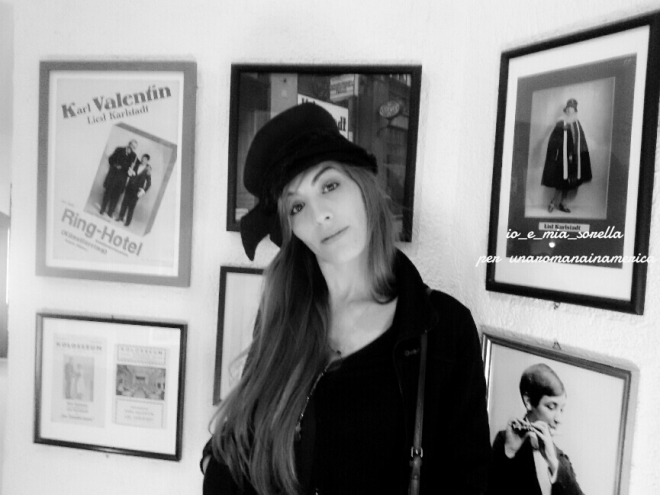
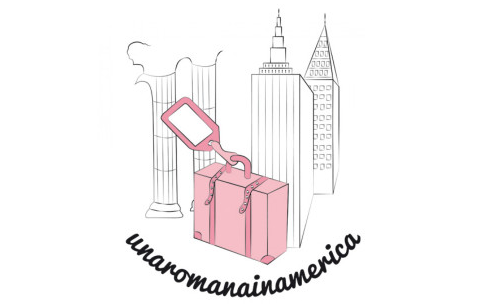

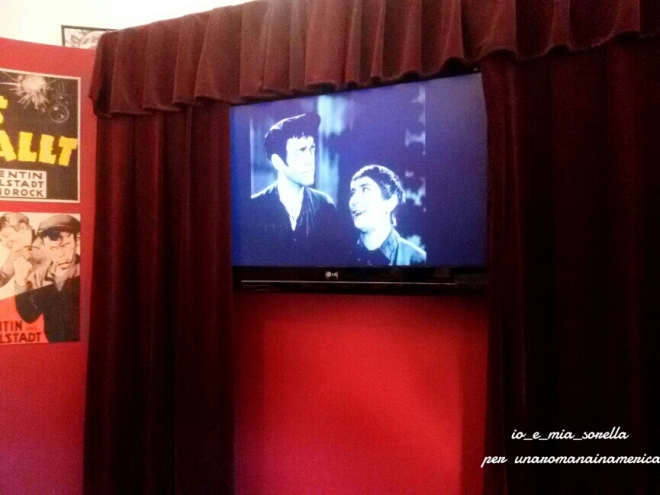
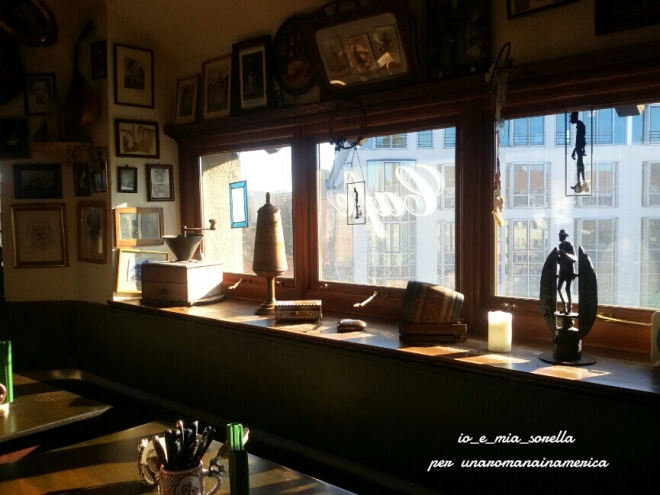
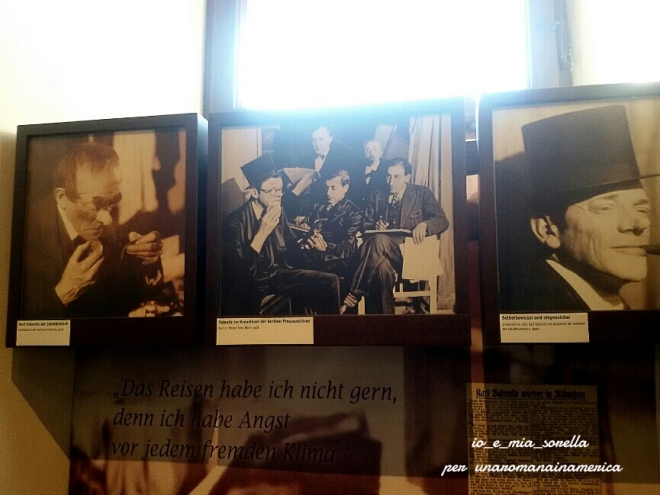



Complimenti Sabrj. Il pezzo è scritto con il cuore ed anche le tantissime foto sono molto belle. Il tuo talento andrebbe premiato… Grazie.
Grazie mille a te, Riki.. il tuo complimento, proprio perché scritto da te, mi illumina la giornata! Sai quanto stimi la tua sensibilità letteraria e la tua intelligenza culturale.. grazie e se passi da queste parti, fatti sentire.. ce ne andiamo in giro a leggere sogni sui muri della città (ce ne sono parecchi, qui, di sogni da realizzare..)
Un abbraccio e grazie ancora,
Sabrina